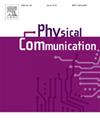Clustering based strategic 3D deployment and trajectory optimization of UAVs with A-star algorithm for enhanced disaster response
IF 2
4区 计算机科学
Q3 ENGINEERING, ELECTRICAL & ELECTRONIC
引用次数: 0
Abstract
A broad spectrum of communication and information technologies is currently being investigated for their potential applications in disaster management. A high level of situational awareness, combined with a prompt and accurate response, is essential for the preservation of life during catastrophe scenarios. This study presents a novel communication strategy employing Unmanned Aerial Vehicles (UAVs) as aerial base stations for providing connectivity to the affected area. The system takes advantage of the flexibility and quick deployment characteristics of UAVs. The main focus is to determine the optimal UAV deployment along with trajectory planning to ensure connectivity in areas where conventional base stations are inaccessible. The proposed system employs two types of UAVs: cluster UAVs which act as stationary base stations and relay UAVs acting as mobile base stations. A three-step strategy is proposed to find the suitable location of cluster UAVs, optimize their height and power, and find the optimal trajectory of the relay UAVs to maximize the percentage of users served. Gaussian Mixture Model (GMM) clustering is employed to determine the optimal horizontal location of cluster UAVs. An optimization problem is framed for finding out the optimal height and power for cluster UAVs. Heuristic-based A-star algorithm is used to find out the trajectory of the relay UAVs which can efficiently minimize the overall path length while avoiding obstacles. The simulation results confirm the effectiveness of the proposed approach and demonstrate the performance enhancement by comparing it with the benchmark schemes.
利用 A-star 算法对无人机进行基于聚类的战略性 3D 部署和轨迹优化,以增强灾害响应能力
目前正在研究各种通信和信息技术在灾害管理中的潜在应用。高水平的态势感知加上迅速准确的响应,对于在灾难情况下保护生命至关重要。本研究提出了一种新颖的通信战略,利用无人驾驶飞行器(UAV)作为空中基站,为灾区提供连接。该系统利用了无人飞行器灵活、快速部署的特点。主要重点是确定无人飞行器的最佳部署和轨迹规划,以确保在传统基站无法到达的地区实现连接。拟议的系统采用两种类型的无人机:作为固定基站的集群无人机和作为移动基站的中继无人机。该系统提出了一个三步战略,即寻找集群无人机的合适位置、优化其高度和功率,以及寻找中继无人机的最佳轨迹,以最大限度地提高服务用户的百分比。采用高斯混合模型(GMM)聚类确定集群无人机的最佳水平位置。为找出集群无人机的最佳高度和功率,提出了一个优化问题。采用基于启发式的 A-star 算法找出中继无人飞行器的轨迹,该轨迹可在避开障碍物的同时有效地最小化总路径长度。仿真结果证实了所提方法的有效性,并通过与基准方案的比较证明了其性能的提升。
本文章由计算机程序翻译,如有差异,请以英文原文为准。
求助全文
约1分钟内获得全文
求助全文
来源期刊

Physical Communication
ENGINEERING, ELECTRICAL & ELECTRONICTELECO-TELECOMMUNICATIONS
CiteScore
5.00
自引率
9.10%
发文量
212
审稿时长
55 days
期刊介绍:
PHYCOM: Physical Communication is an international and archival journal providing complete coverage of all topics of interest to those involved in all aspects of physical layer communications. Theoretical research contributions presenting new techniques, concepts or analyses, applied contributions reporting on experiences and experiments, and tutorials are published.
Topics of interest include but are not limited to:
Physical layer issues of Wireless Local Area Networks, WiMAX, Wireless Mesh Networks, Sensor and Ad Hoc Networks, PCS Systems; Radio access protocols and algorithms for the physical layer; Spread Spectrum Communications; Channel Modeling; Detection and Estimation; Modulation and Coding; Multiplexing and Carrier Techniques; Broadband Wireless Communications; Wireless Personal Communications; Multi-user Detection; Signal Separation and Interference rejection: Multimedia Communications over Wireless; DSP Applications to Wireless Systems; Experimental and Prototype Results; Multiple Access Techniques; Space-time Processing; Synchronization Techniques; Error Control Techniques; Cryptography; Software Radios; Tracking; Resource Allocation and Inference Management; Multi-rate and Multi-carrier Communications; Cross layer Design and Optimization; Propagation and Channel Characterization; OFDM Systems; MIMO Systems; Ultra-Wideband Communications; Cognitive Radio System Architectures; Platforms and Hardware Implementations for the Support of Cognitive, Radio Systems; Cognitive Radio Resource Management and Dynamic Spectrum Sharing.
 求助内容:
求助内容: 应助结果提醒方式:
应助结果提醒方式:


